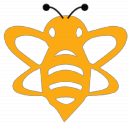Honey Bee Haven
The Black Bee Experience

Honey Bee Haven
The Black Bee Experience
Honey
For many years it was believed that honey bees collected honey from flowers. In fact, their latin name (Apis Mellifera) means the honey bearing bee (The bee collects nectar from the flowers which the flower holds within it nectaries) the nectar is stored in a special honey stomach where a special bee enzyme (called invertase) breaks it down into glucose and fructose.
After visiting up to 1500 flowers, the honey bees stomach will be full of nectar (a full honey stomach weighs almost as much as the bee itself). It will return to the hive to give the nectar and enzyme solution to the house bees.
The house bees then reduce the moisture content of the mixture by a process of eating and regurgitating it. Only then it is placed in honeycomb, where it undergoes its final moisture control process where the house bees fan their wings over it to reduce the moisture still further.
The honey is then capped with a wax cover, ensuring it is ready to use at a later date.
Propolis
Propolis is known as bee glue. It is an incredibly sticky substance the bees use primarily to fill gaps in the hive, however it does have much more important uses.
Many trees produce a sticky resin to protect various parts of the tree from bacteria and fungus. Some of the foraging bees are given the job of going out to collect the propolis. Removing it from the tree with their mandibles, they carry it back to the hive in their pollen baskets.
Once back at the hive, house bees will help them remove the propolis and use it where it is needed.
The propolis has a number of uses within the hive. Mostly it is used for filling cracks and polishing surfaces (including comb cells). On occasion it is used for its antibacterial qualities (of which it has many). Indeed if a mouse dies within a hive (mice have a nasty habit of hibernating in bee hives) the bees will cover it with propolis to ensure that no infection spreads around the hive.
In fact many beekeepers harvest propolis from within the hive, roll it into small balls and use it as a cure for everything from sore throats to bad breath.
Beeswax
Once a honeybee reaches an age of 12 days old she will develop wax glands. The honey bee eats honey and these glands transform sugar from the honey into a wax substance which appears as flakes on the underneath of the bees abdomens.
Other bees then take these wax flakes and chew them to make useable wax from which they make the comb which acts as a food store and nursery for the bee larvae.
©Honey Bee Haven Limited 2015